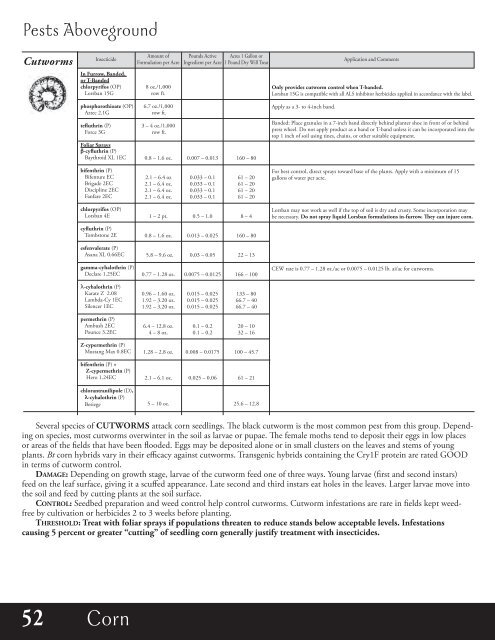Agronomic Crops
mJyPrJ
mJyPrJ
Create successful ePaper yourself
Turn your PDF publications into a flip-book with our unique Google optimized e-Paper software.
Pests Aboveground<br />
Cutworms<br />
Insecticide<br />
In Furrow, Banded,<br />
or t-Banded<br />
chlorpyrifos (OP)<br />
Lorsban 15G<br />
Amount of<br />
Formulation per Acre<br />
8 oz./1,000<br />
row ft.<br />
Pounds Active<br />
Ingredient per Acre<br />
Acres 1 Gallon or<br />
1 Pound Dry Will Treat<br />
Application and Comments<br />
only provides cutworm control when t-banded.<br />
Lorsban 15G is compatible with all ALS inhibitor herbicides applied in accordance with the label.<br />
phosphorothioate (OP)<br />
Aztec 2.1G<br />
6.7 oz./1,000<br />
row ft.<br />
Apply as a 3- to 4-inch band.<br />
tefluthrin (P)<br />
Force 3G<br />
Foliar sprays<br />
b-cyfluthrin (P)<br />
Baythroid XL 1EC<br />
3 – 4 oz./1,000<br />
row ft.<br />
0.8 – 1.6 oz.<br />
0.007 – 0.013<br />
160 – 80<br />
Banded: Place granules in a 7-inch band directly behind planter shoe in front of or behind<br />
press wheel. Do not apply product as a band or T-band unless it can be incorporated into the<br />
top 1 inch of soil using tines, chains, or other suitable equipment.<br />
bifenthrin (P)<br />
Bifenture EC<br />
Brigade 2EC<br />
Discipline 2EC<br />
Fanfare 2EC<br />
2.1 – 6.4 oz<br />
2.1 – 6.4 oz.<br />
2.1 – 6.4 oz.<br />
2.1 – 6.4 oz.<br />
0.033 – 0.1<br />
0.033 – 0.1<br />
0.033 – 0.1<br />
0.033 – 0.1<br />
61 – 20<br />
61 – 20<br />
61 – 20<br />
61 – 20<br />
For best control, direct sprays toward base of the plants. Apply with a minimum of 15<br />
gallons of water per acre.<br />
chlorpyrifos (OP)<br />
Lorsban 4E<br />
1 – 2 pt.<br />
0.5 – 1.0<br />
8 – 4<br />
Lorsban may not work as well if the top of soil is dry and crusty. Some incorporation may<br />
be necessary. Do not spray liquid Lorsban formulations in-furrow. ey can injure corn.<br />
cyfluthrin (P)<br />
Tombstone 2E<br />
0.8 – 1.6 oz.<br />
0.013 – 0.025<br />
160 – 80<br />
esfenvalerate (P)<br />
Asana XL 0.66EC<br />
5.8 – 9.6 oz.<br />
0.03 – 0.05<br />
22 – 13<br />
gamma-cyhalothrin (P)<br />
Declare 1.25EC<br />
0.77 – 1.28 oz.<br />
0.0075 – 0.0125<br />
166 – 100<br />
CEW rate is 0.77 – 1.28 oz./ac or 0.0075 – 0.0125 lb. ai/ac for cutworms.<br />
λ-cyhalothrin (P)<br />
Karate Z 2.08<br />
Lambda-Cy 1EC<br />
Silencer 1EC<br />
0.96 – 1.60 oz.<br />
1.92 – 3.20 oz.<br />
1.92 – 3.20 oz.<br />
0.015 – 0.025<br />
0.015 – 0.025<br />
0.015 – 0.025<br />
133 – 80<br />
66.7 – 40<br />
66.7 – 40<br />
permethrin (P)<br />
Ambush 2EC<br />
Pounce 3.2EC<br />
6.4 – 12.8 oz.<br />
4 – 8 oz.<br />
0.1 – 0.2<br />
0.1 – 0.2<br />
20 – 10<br />
32 – 16<br />
Z-cypermethrin (P)<br />
Mustang Max 0.8EC<br />
1.28 – 2.8 oz.<br />
0.008 – 0.0175<br />
100 – 45.7<br />
bifenthrin (P) +<br />
Z-cypermethrin (P)<br />
Hero 1.24EC<br />
2.1 – 6.1 oz.<br />
0.025 – 0.06<br />
61 – 21<br />
chlorantranilipole (D),<br />
λ-cyhalothrin (P)<br />
Besiege<br />
5 – 10 oz.<br />
25.6 – 12.8<br />
Several species of CUtWoRMs attack corn seedlings. e black cutworm is the most common pest from this group. Depending<br />
on species, most cutworms overwinter in the soil as larvae or pupae. e female moths tend to deposit their eggs in low places<br />
or areas of the fields that have been flooded. Eggs may be deposited alone or in small clusters on the leaves and stems of young<br />
plants. Bt corn hybrids vary in their efficacy against cutworms. Transgenic hybrids containing the Cry1F protein are rated GOOD<br />
in terms of cutworm control.<br />
DAMAGe: Depending on growth stage, larvae of the cutworm feed one of three ways. Young larvae (first and second instars)<br />
feed on the leaf surface, giving it a scuffed appearance. Late second and third instars eat holes in the leaves. Larger larvae move into<br />
the soil and feed by cutting plants at the soil surface.<br />
ContRoL: Seedbed preparation and weed control help control cutworms. Cutworm infestations are rare in fields kept weedfree<br />
by cultivation or herbicides 2 to 3 weeks before planting.<br />
tHResHoLD: treat with foliar sprays if populations threaten to reduce stands below acceptable levels. Infestations<br />
causing 5 percent or greater “cutting” of seedling corn generally justify treatment with insecticides.<br />
52 Crop Corn Name


